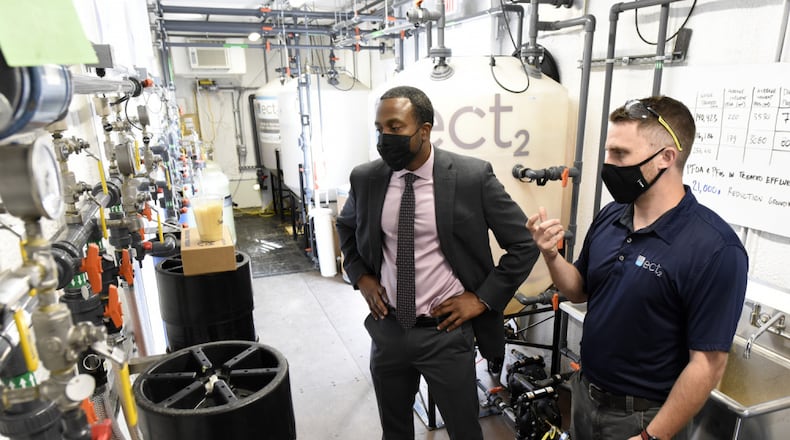Thirteen of the 16 sites are on the base’s Area A, with two on Area B and one off-base to the northeast of the installation.
“Right now there are no unsafe levels of PFAS in treated drinking water here at Wright-Patterson Air Force Base or the city of Dayton,” Baker said.
“This is in ground water,” he said. “It’s not in the drinking water at levels above the LHA (lifetime health advisory).”
The U.S. Environmental Protection Agency has established advisory levels at 70 parts per trillion when it comes to PFOA (Perfluorooctanoic acid) and PFAS (per-and polyfluoroalkyl) chemicals in drinking water.
Wright-Patterson’s environmental restoration team identified priorities and tasks ahead in a virtual public session Monday evening, updating viewers on efforts to detect and treat chemicals in base soil and water.
These chemicals, sometimes called “forever chemicals,” are human-produced substances found in some fire-suppression foams, nonstick cookware and industrial products.
Firefighters sprayed the suppressant, known as “aqueous film forming foam,” to fight aircraft fires and used it in training for decades. Wright-Patterson shut down two drinking production wells in Area A in May 2016. In June 2016, Dayton shut down seven water production wells closer to the base at Huffman Dam as a “precautionary measure.”
Base officials said they haven’t used the problematic fire suppression foam since 2016. But the substances have been linked to cancer and other health issues, and have become a local and national concern.
As of Sept. 30, 2021, base officials said they had pumped 7.8 billion gallons — “7,836,784,305″ gallons was the number given — from one extraction well, collecting influent and effluent samples.
Two former munitions sites on the base, including a former skeet range, are also being investigated.
In all, more than 100 monitoring wells are to be installed, with more than 372 soil samples collected in addition to other work, listeners were told at the meeting held over Microsoft Teams.
John Crocker, a remedial project manager at the base, said sampling in the proximity of fire training areas and elsewhere will document the effectiveness of different water treatment systems. “We’ll be collecting samples at 21 locations, upstream and downstream,” prior to and after treatment, he said.
With Army engineers, the base last year launched a $26.5 million effort to deal with PFAS chemicals. Two areas on base — sites the base said were found to have the “greatest potential to impact public drinking water sources” — were an area of initial focus.
Last summer’s remedial work started about two months after Dayton city government sued Wright-Patterson and the U.S. Department of Defense in federal court, alleging the base failed to stop PFAS chemicals from entering city water.
A base representative told the Dayton Daily News last year the remedial work was not a response to the suit. In mid-August, the suit was transferred to a federal court in South Carolina. (The most recent filing in the case as of Tuesday was from August, noting the transfer of the case from Ohio.)
Wright-Patt and DoD officials have denied the city’s allegations in the lawsuit, saying they have followed federal guidelines to ensure contaminants migrating from the base remain below federal recommended levels. By the city’s own admission, base representatives have maintained, Dayton’s water is safe to drink.
“We’ve been re-engaging recently with the city of Dayton and the regulators to get more communication going back and forth with everybody,” Crocker said Monday.
City representatives did not immediately answer questions Tuesday about the city’s work with the base on the issue.
About the Author

